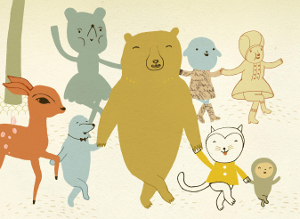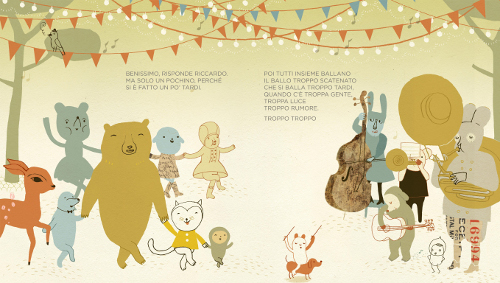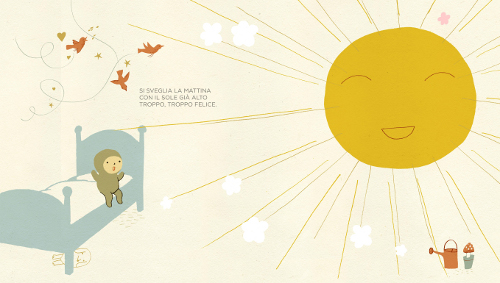Cristiana Clerici’s International Spotlight #1:
Giovanna Zoboli and Camilla Engman’s Too Late
 September 28th, 2010 by jules
September 28th, 2010 by jules
 I’m so pleased that today marks Italian blogger Cristiana Clerici’s first contribution to 7-Imp. You may remember from this early September post that I invited her to come on over to the 7-Imp salon to discuss international picture book titles whenever the mood strikes her. Lucky for me, she was all fired up about that idea. You may also remember from my introductory post on Cristiana that over at her blog, The Tea Box, where she will cross post these reviews and interviews, she is following books from all over — with special attention to Italy, the United States, the UK, France, Spain, and South American countries. And she maintains three pages in three languages over at The Tea Box (Italian, English, and French). Hubba whoa did you say? Yes, hubba WHOA. Impressive, indeed.
I’m so pleased that today marks Italian blogger Cristiana Clerici’s first contribution to 7-Imp. You may remember from this early September post that I invited her to come on over to the 7-Imp salon to discuss international picture book titles whenever the mood strikes her. Lucky for me, she was all fired up about that idea. You may also remember from my introductory post on Cristiana that over at her blog, The Tea Box, where she will cross post these reviews and interviews, she is following books from all over — with special attention to Italy, the United States, the UK, France, Spain, and South American countries. And she maintains three pages in three languages over at The Tea Box (Italian, English, and French). Hubba whoa did you say? Yes, hubba WHOA. Impressive, indeed.
Cristiana is working on an interview with the very talented Italian illustrator Eva Montanari, which she’ll also post over here, once she wraps that up. Today she’s contributed a review of the book you see pictured below, written by one of the leading authors in Italian children’s literature and illustrated by a Swedish artist. The book is being published in France by Hélium. It’s looking for a publisher in other countries, says Cristiana. (More information can be found here.)
Without further ado, here’s Cristiana to tell you more about it, and I thank her kindly… (By the way, I need a clever title for Cristiana’s series of sorts. Any ideas? It’s late, and “Cristiana Clerici’s International Spotlight” is the best I can do.)
Cristiana: What does “too late” really mean? When you’re too little, “too late” is nothing but a vague expression. For everybody, too late is too-something: for some it’s too cold; for others, too dark. But they all agree that it’s too late!
For Riccardo, Too Late is a little dot in the distance, a place he would like to explore, if only the road wasn’t too long and dark and empty, if only he were older and he had the courage to leave for this trip.
What about if an unusual bunch of friends came along with him? Maybe a bear on his bicycle, a white cat with prodigious sight, and Mrs Doe with her big, sweet eyes. But where could he meet such an eccentric party? Maybe on the threshold of the wood, or maybe at the border between reality and dream.
Too Late is a faraway place, beyond the sleeping wood and dozing hills.
Too Late is a place that is accessible only to those people daring to reach it.
In Too Late there’s everything too much: people, music, dances, noise, and bright lights. And Riccardo, in the end, is too little to stay up so late.
But, luckily, the too big Bear can take him away from the crowd, the too agile Cat can sneak through people, and the too tuneful Mrs. Doe can sing him a sweet lullaby.
This way, when he wakes up, Riccardo will remember nothing but the joyful moments: the trip to Too Late, the friends, having shared a fantastic experience with them, something sweet and precious he nursed with the warmth of his dreams.
A picture book of discovery and adventure, of friendship, or rather of brotherhood, teaching with a silky, smooth, naturalness how easy it can be to be united when you share the same path, no matter if it’s for Too Late or for life. A picture book where you learn to place your trust in others, calmly.
It’s the second time I review a picture book written by Giovanna Zoboli. For the second time, I find subtle and refined linguistic skills. Leaving behind the expressive hermeticism she used in Vorrei Avere, in Troppo Tardi she uses a playful language, full of crackling alliterations and engaging repetitions that take us to a faraway place.
I had fun reading the book aloud over and over again. I stumbled several times trying to read it quickly. I’ve never been good at this, though the rhythm of this text is skillfully enthralling. I laughed more than once while repeating all those tr, tr, tr, tr that reminded me, according to the scenario I had in front, the cheerful chugging of a motorbike or a drum roll.
What can I say about Camilla Engman’s illustrations? For those who still don’t know her, the surprise will be a very nice one. Her narration through images is so well-balanced: the concreteness she uses to represent adults, within their environment, slowly looses its boundaries with the progression of the story. She obtains this by adding little particulars that are just outlined, almost invisible, alluding though to a change in the narrative pace. We find little animals asleep in the forest, unlikely rainbows, a mouse in his den, the hills on the way back from Too Late exploding, as if they were to fill in the emptiness of the dark night: these are all little stones Engman sows to mark the way towards that mysterious place, a place where you can find too much of too much. It’s a delicate narration, full of joy and reassuring, with a firmly balanced use of colour: never more than four-five colours each table, natural shades, light strokes. Her characters are well-defined but smooth and comforting at the same time.
It’s a lovely picture book I would suggest not just for bedtime but for a read-aloud session at school.
Let me tell you something about Giovanna Zoboli and Camilla Engman:
Born in Milan, Giovanna Zoboli is a leading personality in Italian children’s literature. She has covered several roles in the publishing business: in fact, she has been editor, writer, and author. Besides picture books, she writes poetry and, in 2005, she wrote a graphic novel for adults, titled Una Vita for Guanda Publishing. In 2004, together with Paolo Canton, she founded the Publishing House Topipittori where she still works. She has obtained several important acknowledgements, such as the prestigious Premio Andersen for the best picture book ages 0-6 and the White Ravens Award in 2004 and 2005.
Giovanna, whom I’ve had the pleasure to meet in person, is for sure a complex personality: behind an apparent rock-like first impression, she hides an extremely careful and sensitive woman. Cultivated, never presumptuous, most likely no more intransigent with others than she is with herself, Giovanna has the pungent glance of those people who are always digging into depths and two motherly arms ready for gentleness as much as reproach, if necessary. Behind a necessarily practical mind, vital especially if you’re in the publishing business, she is passionate about written and illustrated words. Her texts reveal many things about her. My favourite ones are those she polishes as any good artisan would do (like Marguarite Yourcenar would say), where nothing is redundant: those clean, at times sharp, sentences containing all you have to know, those sentences that only someone who writes poetry can produce.
Camilla Engman is a complete artist: in fact, she is illustrator as well as graphic designer and painter. The complexity of her work can be admired both on her web page and charming blog. Camilla is from Trollhättan in Sweden. She has a degree in Design and Craft and a Master of Fine Arts. Since she ended her studies, she has been a freelance artist, though in her youth she has worked as well in a hairdressing salon, as a cleaner, and at a car factory for some time until she finally decided to take art studies and, thanks god, she did! Hadn’t she, we would have missed her a lot!
What strikes me about her images is their cleanness, their coherent insight, the essential colours she uses — muted colours, in fact. As she partly explains in this interview, she never uses vivid ones. Her illustrations, like her paintings, are never overloaded with elements: the key point of her images is always well-focused and clear, the characters well-outlined, the background often white or formed by few objects and light colours. In those images, only apparently simple, her inspiration pops out by surprise in little details that are just outlined, seemingly hidden on purpose, as if the reader had to make the effort to catch them. Besides the constant presence of Morran, her beloved dog, her imagination is enriched by bizarre little animated creatures, mainly quickly sketched, that confer to her tables a sometimes funny, sometimes ironic or sweet, though always surprising, side. Her collages, obtained using little objects she finds here and there, are little masterpieces you shouldn’t miss!
I became very curious when I read what she declared about sisterhood and friendship. Her words made me think of Troppo Tardi. I thought they captured the essence of the book: “[A sister/friend is] {s}omeone who loves you even when you are ugly inside/outside. And someone who wants to follow you on your adventures.” In the end, isn’t that happy bunch of friends in the book a bit strange? Though they leave together to make Riccardo’s dream come true! Also, here’s what she says about her creative approach to things: “I like that things can change on the way, how expressions just form themselves, and how [the journey] gets me into different unexpected situations.” Doesn’t this remind you of the trick the book contains about “too late” in its common “adult” use and Too Late becoming a place in Riccardo’s mind? To me it all made sense! If you’re interested, you can read the full interview here.
And another interview you shouldn’t miss is this!
TROPPO TARDI. Illustrations © 2010 Camilla Engman. Published by Topipittori, Milan. All rights reserved.






Reading reviews like this make me dream of setting up my own publishing house so that I could publish this in English – it sounds wonderful, though also a challenge to translate! Cristiana – I also really liked the background info on the author and illustrator. I can’t wait for more contributions from you here on 7-Imp.
I love the European sensibilities of design. It just feels so much more sophisticated in terms of color palette and especially the willingness to experiment in terms of representation and looseness of linework
Love it! Thanks for sharing Jules.
oh my, camilla’s new book AND and interview on my favorite illustrated book review site? now, that is impossible! thank you!
Hi to everybody! Thank you so much for all the nice comments and support, I do appreciate it. I’m happy you liked the book, and the presentation of author and illustrator, much more to come! 🙂
@Dan: I believe there are so many interesting artists out there, you’re one for me! I love your work. As for art, I believe Camilla – for instance – is very rooted in her country and, starting from the color palette, she gives such a great representation of “Swedishness” (I wouldn’t know how to express this better)… 🙂
@Zoe: Thank you, I wish I could have my own publishing house too!
I’m happy to be learning about more international children’s book creators!!! =D
This is what I call a complete, deep revew, dear Cristiana. You did a very good job. 🙂 Thank you for representing our country and our beautiful picture books in this blog and thanks to 7-imp. for giving hospitality to Italian books and editors.
[…] Italian, makes it even more romantic but I do hope there is an English version too. You can read a great book review here…and you can order it here at […]